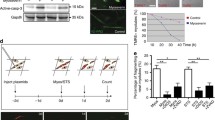Summary
We propose that when skeletal muscle regenerates after injury, myogenic precursor cell replication commences earlier if the muscle has undergone a recent previous cycle of regeneration. To test this a series of muscles in mice were crush-injured and allowed to regenerate. Then either 7 or 28 days after the initial injury, the muscles were reinjured. The onset of DNA synthesis in myogenic precursor cells was determined by injecting each mouse once with tritiated thymidine at a specific time after the second injury. All reinjured muscles were left for 10 days to regenerate to the myotube stage. The presence of autoradiographically labelled myotube nuclei indicated that these nuclei were the progeny of myogenic precursors labelled at the time of injection of tritiated thymidine. Thus the onset of muscle precursor cell replication was determined. A similar series of experiments was conducted on muscle autotransplants, injured at 28 days after transplantation and sampled 10 days later. In none of these situations did muscle precursor cell replication occur earlier than in control muscles, which were injured only once, where myogenesis commenced between 24 and 30 h after injury. The autoradiographic data do not support our hypothesis. We conclude that the increased numbers of muscle precursors reported (by various authors) after repeated cycles of regeneration, are not due to the earlier initiation of DNA synthesis in myogenic preoursor cells.
Similar content being viewed by others
References
Basson MD, Carlson BM (1980) Myotoxicity of single and repeated injections of mepivacaine (Carbocaine) in the rat. Anaesth Analg 59:275–282
Benoit PW, Belt WD (1970) Destruction and regeneration of skeletal muscle after treatment with a local anaesthetic, bupivacaine (Marcaine). J Anat 107:547–556
Carlson BM, Faulkner J (1983) The regeneration of skeletal muscle fibres following injury: a review. Med Sci Sports Exerc 15:187–198
Church JCT (1970) Cell quantitation in regenerating bat web muscle. In: Mauro A, Shafiq SA, Milhorat AT (eds) Regeneration of striated muscle and myogenesis. Exerpta Medica, Amsterdam, pp 101–118
Cleaver JE (1967) Thymidine metabolism and cell kinetics. North Holland, Amsterdam
Dilley RJ, McGeachie JK (1983) Block staining with p-phenylenediamine for light microscope autoradiography. J Histochem Cytochem 31:1015–1018
Grounds MD, McGeachie JK (1987) Reutilisation of 3H-thymidine in studies of regenerating skeletal muscle. Cell Tissue Res 250:141–148
Grounds MD, McGeachie JK (1989) A comparison of muscle precursor replication in crush injured skeletal muscle of Swiss and BALBc mice. Cell Tissue Res 255:385–391
Gulati AK (1986) Pattern of skeletal muscle regeneration after reautotransplantation of regenerated muscle. J Embryol Exp Morphol 92:1–10
Gulati AK, Zalewski AA (1985) An immunofluorescent analysis of lectin binding to normal and regenerated skeletal muscle of rat. Anat Rec 212:113–117
Hansen-Smith FM, Carlson BM (1979) Cellular responses to free grafting of extensor digitorum longus muscle of the rat. J Neurol Sci 41:149–173
Mong FSF (1988) Satellite cells in the regenerated and regrafted muscle of rats. Experientia 44:601–603
McGeachie JK, Grounds MD (1987) Initiation and duration of muscle precursor replication after mild and severe injury to skeletal muscle of mice. Cell Tissue Res 248:125–130
Roberts P, McGeachie JK, Grounds MD, Smith ER (1989a) The initiation and duration of myogenesis in transplants of intact skeletal muscles: an autoradiographic study in mice. Anat Rec 224:1–6
Roberts P, McGeachie JK, Smith ER (1989b) Endothelial cell activation during angiogenesis in freely transplanted skeletal muscles in mice, and its relationship to the onset of myogenesis. J Anat (submitted)
Sadeh M, Czyzewski K, Stein LZ (1985) Chronic myopathy induced by repeated bupivacaine injections. J Neurol Sci 67:229–238
Schultz E, Jaryszak DL (1985) Effects of skeletal muscle regeneration on the proliferation potential of satellite cells. Mech Ageing Dev 30:63–72
Studitsky AN (1974) The neural factor in the development of transplanted muscles. In: Milhorat AT (ed) Exploratory concepts in muscular dystrophy II. Exerpta Medica, Amsterdam, pp 351–367
Walker BE (1963) The origin of myoblasts and the problem of dedifferentiation. Exp Cell Res 30:80–92
Walker BE (1970) Skeletal muscle regeneration in young rats. Am J Anat 133:369–378
Watt DJ, Morgan JE, Clifford MA, Partridge TA (1987) The movement of muscle precursor cells between adjacent regenerating muscles in the mouse. Anat Embryol 175:525–536
Author information
Authors and Affiliations
Rights and permissions
About this article
Cite this article
Morlet, K., Grounds, M.D. & McGeachie, J.K. Muscle precursor replication after repeated regeneration of skeletal muscle in mice. Anat Embryol 180, 471–478 (1989). https://doi.org/10.1007/BF00305122
Accepted:
Issue Date:
DOI: https://doi.org/10.1007/BF00305122




